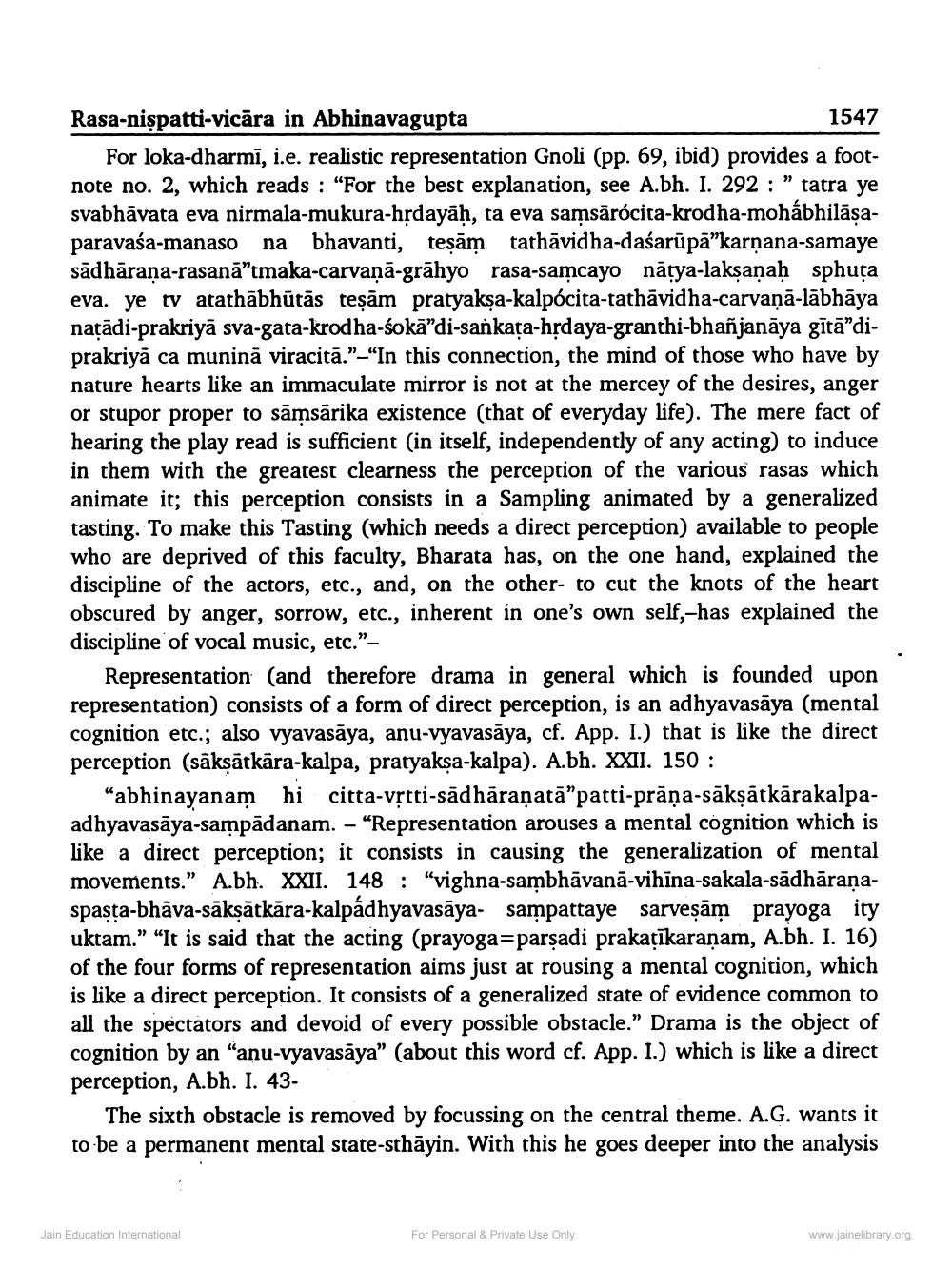________________
Rasa-nişpatti-vicāra in Abhinavagupta
1547 For loka-dharmī, i.e. realistic representation Gnoli (pp. 69, ibid) provides a footnote no. 2, which reads : "For the best explanation, see A.bh. I. 292 : ” tatra ye svabhāvata eva nirmala-mukura-hỉdayāḥ, ta eva samsārócita-krodha-mohábhilāșaparavasa-manaso na bhavanti, tesām tathāvidha-dasarūpā"karnana-samaye sādhāraṇa-rasanā”tmaka-carvaņā-grāhyo rasa-samcayo nāțya-lakṣaṇaḥ sphuţa eva. ye ty atathābhūtās tesām pratyaksa-kalpócita-tathāvidha-carvanā-lābhāya națādi-prakriyā sva-gata-krodha-śokā”di-sankața-hrdaya-granthi-bhañjanāya gītā”diprakriyā ca muninā viracitā.”_“In this connection, the mind of those who have by nature hearts like an immaculate mirror is not at the mercey of the desires, anger or stupor proper to sāmsārika existence (that of everyday life). The mere fact of hearing the play read is sufficient (in itself, independently of any acting) to induce in them with the greatest clearness the perception of the various rasas which animate it; this perception consists in a Sampling animated by a generalized tasting. To make this Tasting (which needs a direct perception) available to people who are deprived of this faculty, Bharata has, on the one hand, explained the discipline of the actors, etc., and, on the other- to cut the knots of the heart obscured by anger, sorrow, etc., inherent in one's own self,-has explained the discipline of vocal music, etc.”
Representation and therefore drama in general which is founded upon representation) consists of a form of direct perception, is an adhyavasāya (mental cognition etc.; also vyavasāya, anu-vyavasāya, cf. App. I.) that is like the direct perception (sākṣātkāra-kalpa, pratyakşa-kalpa). A.bh. XXII. 150 :
"abhinayanam hi citta-vịtti-sadhāraṇatā"patti-prāņa-säksātkārakalpaadhyavasāya-sampādanam. – “Representation arouses a mental cognition which is like a direct perception; it consists in causing the generalization of mental movements." A.bh. XXII. 148 : "vighna-sambhāvanā-vihina-sakala-sādhāranaspasta-bhāva-sākṣātkāra-kalpádhyavasāya- sampattaye sarveșām prayoga ity uktam.” “It is said that the acting (prayoga=parsadi prakațīkaranam, A.bh. I. 16) of the four forms of representation aims just at rousing a mental cognition, which is like a direct perception. It consists of a generalized state of evidence common to all the spectators and devoid of every possible obstacle." Drama is the object of cognition by an "anu-vyavasāya" (about this word cf. App. I.) which is like a direct perception, A.bh. I. 43
The sixth obstacle is removed by focussing on the central theme. A.G. wants it to be a permanent mental state-sthāyin. With this he goes deeper into the analysis
Jain Education International
For Personal & Private Use Only
www.jainelibrary.org




